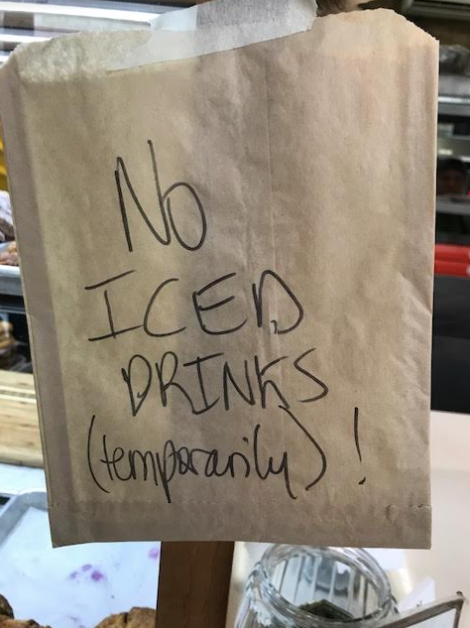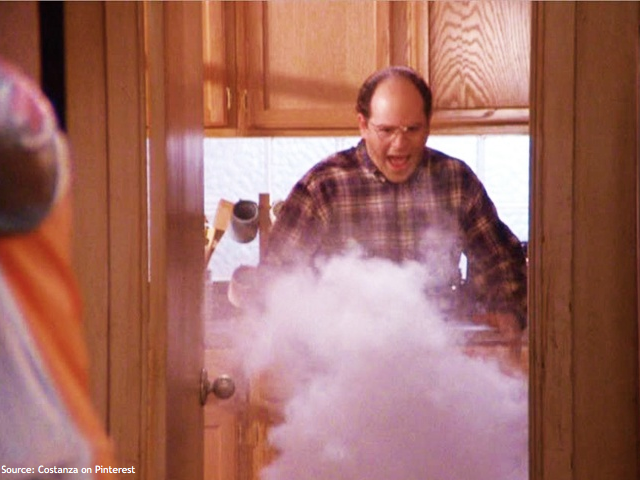Every business has gritty customer-facing elements where operating challenges emerge. Systems go down; people call in sick, stuff happens! How you lead during and after speaks volumes to your people and your customers. Calm, confident leadership is your "go to." Here's how...
Cool-headed, poised, composed – select whatever words you like, good leaders model calm. They also inspire their team to do the same.
It was an inferno in there, an inferno! – George Costanza
Seinfeld has most situations in life covered. How they do it, that’s a different story. A classic scene is George’s Constanza’s heroism on display as a fire broke out at a children’s birthday party. He screamed and then proceeded to trample children, the elderly and even the party clown.
If you forget or haven’t seen it yet, it’s only 13 seconds. Give it a look.
How Good Leaders Model Calm
It’s often less what you say and more how you manage your energy with everyday challenges. When it’s all over, people comment on your leadership presence – were you part of the solution or part of the problem?
As a leader, this is excellent news. Afterall, you get what you model. You just need to decide and follow through
I am a coffee geek and love hipster joints that pair great coffee with a comparable vibe. I walked into one of my favorites and came across this “sign.”

No ice drinks for a happening NYC hipster coffee place at 10 am in the morning, is a real problem. I expected the staff and customers to be out of sorts because of it. They were not.
Things seemed to be running fine. Customers saw the sign and chit-chatted with the seemingly upbeat staff. Everyone ordered something, and the cycle repeated itself.
A couple of reasons for the sense of calm became evident:
- The owner had his head in the freezer. I mean in it. Rather than push one of his staff in there, he was working to fix things. Hard to tell if he even knew how. Regardless, he was trying.
- He would occasionally pop his head out of the freezer and made jokes to his staff and the customers. He is well liked. The owner was using some of his personal equity (yes that exists in small businesses too), to keep the vibe positive and things moving in his shop.
- As the staff saw regular iced coffee drinkers enter, they proactively joked about the sign, thanked the customers for hanging in and “acted as if” they would order something else. The customers did just that. All positive exchanges from what I saw.
OK, No Iced Coffee, So What!
There are hundreds of excellent coffee places in NYC. There are choices even in proximity. I’m guessing this shop didn’t lose much if any business that day. They were working a problematic situation with a sense of both calm and humor. It made you want to rally around them, even come back and make sure they were ok.

Now all of this may seem a small thing. After all, there are stories of heroic leadership exhibited in situations far grander. While there are examples of such heroism, it is way more common to face this type of gritty operating challenge.
Be sure, relevant leadership stories evidence in the day to day of business. As such, how you handle these situations is an essential input to your reputation.
Related Post: Inconvenience Gives Way To Perspective If You Allow
The Same Basics Apply For Developing Your Leadership Presence
Most every business has a gritty, transaction-oriented customer-facing component. Things go wrong equivalent to the ice maker breaking.
Systems go down; people call in sick, sh*t happens!
How you deal with it screams to your team and clients/customers. Your response says something quite significant about your organization and you personally as a leader.
It is hard to watch when you see someone come undone trying to manage a difficult situation. Not all cases will flow as even as the one in the coffee shop. More complex problems with internal and external customers surface. While more complicated, it is still about digging in with a sense of calm and purpose.
Your team and your customers will have a long memory for how you handle all of it.
Thankfully, it’s nearly almost impossible not to root for someone who manages with calm and humor as they try and fix something.

The 5 basics for leading through the day to day stressors:
- Tell people what’s going on. The “no ice” sign was way better than every person having to ask.
- Stand in front. Put your head in the freezer or whatever is the equivalent to demonstrate you are in it with your team and will help fix it.
- Keep it real. Calm, humor, irritability and panic are contagious. Pick the first two not the last.
- Keep going. Get ahead of whatever you can. Neither ignore it or create drama. And, keep running the business
- Close it out. Connect back to people and process after the fact – see below.
After The Fact
Two essential items to deal with after the fact – the people and the process.
First, on the people. I wasn’t there at the end of shift/day wrap up at the espresso shop, but I guarantee the owner acknowledged and thanked his team for rallying that day.
Your employees have dealt with something, presumably in a way that you are proud. It’s important they know that.
The second dimension of people is your customers or clients. The proportional response will depend on the level of inconvenience amount of patience you’ve tested, but being intentional about follow up is a must.
Finally, there is a process.
Good leaders model calm, then they deal what happened. Your team (and your customers) will expect you to figure out how and why the proverbial freezer broke. It’s frustrating for people to live through the same issue over and over.
In a quiet moment, deal with the underlying causes to prevent reoccurrence. In more involved situations where an immediate “fix” isn’t possible, affordable, you will need to identify some contingency plans. What will you do if this happens again?
You don’t want Groundhog’s Day for your people and customers!
You lead by example, whether you intend to or not. pic.twitter.com/UiGsyrtCVd
— Steve Keating (@LeadToday) March 10, 2018
Leading Through Everyday Stressors Builds Resiliency
On the plus side, managing through the day to day challenges binds teams and helps foster a resilient culture. Things will happen. You and your teams can and will get through it, together.
Not to sound too dramatic but…you decide how you show up in these situations. Show up with the best version you’ve got! Great near and longer-term outcomes will emerge.
Good leaders model calm by taking control with quiet confidence. You will see this same calm leadership evidence in your people. Acknowledge and celebrate it.
This reinforcement will solidify behaviors and that resiliency you want.
What version of you are your people experiencing as you handle things?
QUESTION:
What advice do you have for keeping it all together during stressful situations?
Please know that sharing your comments below & across this audience matters. A robust conversation to benefit all can and will break out! Thank you in advance for sharing and engaging.
Dig Deeper
Here is a TED talk about stress. We commonly speak of it as the enemy; this video called How To Make Stress Your Friend takes a different look.
Tools You Can Use
For a printable PDF of this post, click here.
Speaking of challenges, communicating about change is one for leaders. Download a tool HERE to help – Communicate Organizational Change So It Doesn’t Kill Your People (Or You!)


What a great way to get at one of leadership’s most daunting challenges. Of course, it helps if your natural state is relatively placing to begin with. For those of us with a vastly different personality type, however, summoning the power to be calm requires a very conscious effort. But as you say. we decide how we show up in these situations, and the more we encounter them (I believe), the less effort is required.
Thanks for the thoughtful and thought-provoking piece.
Excellent point Peter. Calm is more of a natural move for some than others. Not a criticism. Calm in many ways is a proxy for consistency. People want to know they can count on you for quiet confidence to persevere. The style of that can actually be quite different. Thanks for weighing in. Thoughtful as always!
Loved the piece. Totally agree and good reinforcing of sound advice.
Thanks Chris!